Posts in Category: Pet-Friendly Holidays
Keeping Pets Safe for the Holidays
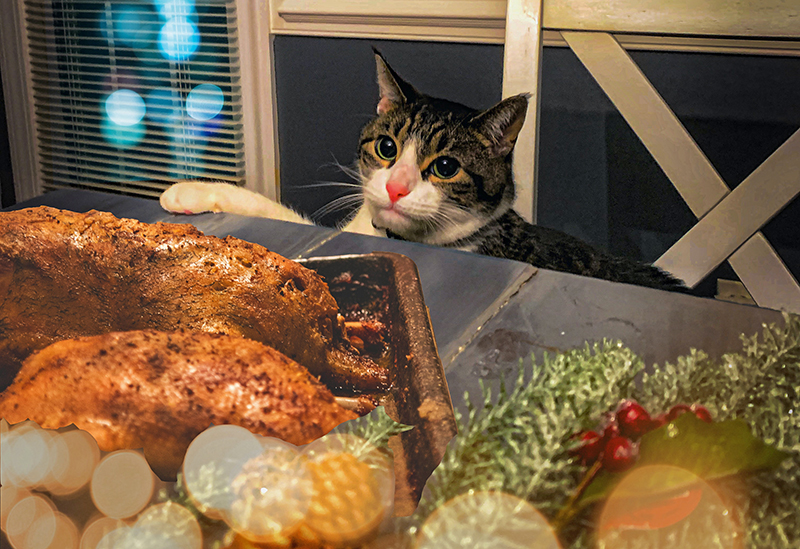
Lee esto en español —>
Happy Paw-lidays! As festivities begin, we want all involved to have a joyful and safe holiday season. Here are some tips to help you keep your four-legged loved ones out of mischief:
No Pawcuterie Boards, Please!
Many already know chocolate is a big no-no for our pets, but keep in mind that almost all human food is high in fat content—and that can lead to big issues! Keep any alcohol, bones, fatty, sweet, or spicy foods in places your pet cannot reach. Visit the ASPCA website for some great information on what not to feed
Instead of human food, consider keeping the dinner portion of your pet’s food in a container for yourself and your guests to use as “treats” throughout the evening.
Instead of showing your love through food, consider switching out toys (perfect excuse for an early gift), adding catnip to some new or old favorite ones, or looking up some fun DIY food puzzles to make with the family!

Tempting Trash
Keep trash away from your pets by securing the lids or taking it out immediately. Think about what we’re likely to throw away…
- Fats and bones can lead to obstructions, pancreatitis, vomiting, diarrhea, and other issues that can result in a veterinary emergency.
- Leftover dough can rise in your pet’s belly and cause bloat.
- Leftover sweets can contain xylitol (sugar substitute), which can cause low blood sugar, seizures, liver failure, or even death.
- Strings/tinsel, aluminum foil, plastic wraps, and broken ornaments/glass can cause foreign body obstructions and serious injuries.
- Old batteries can cause acid burns all the way from the mouth to the stomach!
Open Flames and Toxic Essential Oils
Keep your eye on any open flames, including menorahs, scented candles, stoves, or fireplaces, and keep them out of reach, since you are more likely to be distracted during this busy time.
Essential oils are not only irritating to our pets’ sensitive noses, but cats can absorb the oils through their skin or lick it off their fur after it has been diffused in the air. Toxicity can occur quickly or after prolonged exposure.
- Cinnamon, citrus, peppermint, pine, pennyroyal, sweet birch, tea tree (malaleuca), wintergreen, and ylang ylang oils are all toxic to cats.
Instead of essential oils to scent your home, consider baking cookies right before guests arrive (or every night; we don’t judge).
Holiday Paw-ties and Decor
- Christmas trees
- Keep secure by tying to the ceiling or doorframe and secure with a sturdy tree stand. Cat parent pro tip: Place horizontal and vertical scratching posts near the tree. Providing both types of scratching posts will increase the chances of your kitty using the post instead of the tree!Do not allow your pets to drink the water from live trees as this can cause gastrointestinal upset. Also, do not add aspirin, sugar, or any other additives to the water.
- Keep tinsel and ornaments that can be broken or that are made from food-based materials (such as salt-dough) out of reach of pets to avoid injuries such as intestinal blockage.
- Electrical cords and lights
- Chewing on the cords and lights can cause severe burns. Consider covering the cords with PVC pipes, offering alternatives like chew toys and treats, or using pet-safe bitter spray to keep from chewing cords.
- Unplug decorations when not in use.
- Flowers and festive plants
- Many common holiday plants can be poisonous to pets if ingested. Visit the ASPCA Animal Poison Control Center for a list of plants that are toxic to dogs and cats.
This time of year can also be louder than usual at home and in the neighborhood. For information on helping your pets get through loud noises, such as fireworks, see our June blog post.
We will be closed from December 24 through 27 and from December 31 through January 2, so please contact your local 24/7 clinic or call ASPCA or the Pet Poison Helpline (see numbers below) if you’re unsure of next steps. While consultation fees may apply (usually between $65 and $75), knowing the next steps for the health of your pet is priceless!
ASPCA Poison Control: (888) 426-4435
365 days a year, 24/7
Pet Poison Helpline: (855) 764-7661
365 days a year, 24/7
– Dr. Ana Valbuena
Como mantener las mascotas seguras durante los días festivos!
¡Felices fiestas! ¡A medida que comienzan las festividades, queremos que todos los involucrados tengan una temporada navideña alegre y segura! Aquí hay algunos consejos para ayudarlo a mantener a sus seres queridos de cuatro patas fuera de las travesuras:
¡No a las tablas de ‘pawcuterie’, por favor!
- Muchos ya saben que no se les puede dar chocolate a nuestras mascotas, pero tenga en cuenta que casi todos los alimentos humanos son altos en contenido de grasa y pueden causar problemas. Mantenga cualquier tipo de alcohol, huesos, alimentos grasosos, dulces o comidas picantes en lugares fuera del alcance de sus mascotas. Visite el sitio web de ASPCA para más información sobre alimentos a evitar.
- En lugar de comida humana, considere mantener la porción de la cena de sus mascotas en un recipiente para usarlo como “golosinas” durante toda la noche.
- En lugar de mostrar su amor a través de la comida, considere cambiar los juguetes (excusa perfecta para un regalo temprano), agregar ‘catnip’, o comprar/’DIY’/hacer rompecabezas de comida con la familia.

Basura tentadora
- Mantenga la basura alejada de sus mascotas asegurando las tapas o sacándola inmediatamente. Piensa en lo que es probable que tiremos a la basura…
- Grasas y huesos pueden provocar obstrucciones, pancreatitis, vómitos, diarrea y otros problemas que pueden resultar en una emergencia veterinaria.
- La masa sobrante puede elevarse en el vientre de sus mascotas y causar distensión abdominal.
- Los dulces pueden contener xilitol (sustituto del azúcar), que puede causar niveles bajos de azúcar en la sangre, convulsiones, insuficiencia hepática o incluso la muerte.
- Las cuerdas / oropel, el papel de aluminio, las envolturas de plástico y los adornos / vidrios rotos pueden causar obstrucciones y lesiones graves.
- Las baterías viejas pueden causar quemaduras de ácido desde la boca hasta el estómago.
Llamas abiertas y aceites esenciales tóxicos
- Mantenga su ojo en cualquier llama abierta como menorás, velas perfumadas, estufas o chimeneas durante esta temporada y manténgalas fuera de su alcance, ya que es más probable que nos distraigamos durante este tiempo.
- Los aceites esenciales no solo son irritantes para la nariz sensible de nuestras mascotas, sino que los gatos pueden absorber los aceites a través de su piel o lamerlo de su pelaje después de ser difundidos en el aire: la toxicidad puede ocurrir rápidamente o después de una exposición prolongada.
- La canela, los cítricos, la menta, el pino, el poleo, el abedul dulce, el árbol de té (malaleuca), la gaulteria y los aceites de ylang ylang son tóxicos para los gatos.
- En lugar de aceites esenciales, considere hornear galletas justo antes de que lleguen los invitados (o todas las noches- no juzgamos).
Fiestas y decoración navideña
- Árboles de Navidad
- Asegure el árbol navideño atándolo al techo o al marco de la puerta y asegúrelo con un soporte de árbol resistente.
-
Consejo profesional para padres de gato: coloque un poste de rascado horizontal y vertical cerca del árbol
- ¡Proporcionar ambos tipos de postes para rascar aumentará las posibilidades de que su gatito use el poste en lugar del árbol!
- No permita que sus mascotas beban el agua de los árboles vivos, ya que esto puede causar malestar gastrointestinal.
- No agregue aspirina, azúcar o cualquier otro aditivo al agua.
- Mantener los adornos y el oropel que se pueden romper o hacer de materiales a base de alimentos, como la masa de sal, debe mantenerse fuera del alcance de las mascotas para evitar lesiones como la obstrucción intestinal.
- Cables eléctricos y luces
- Masticar los cables y las luces puede causar quemaduras graves, así que considere cubrir los cables con tubos de PVC, ofrezca otras alternativas de masticación como juguetes y golosinas, o compre aerosol amargo que sea seguro para mascotas.
- Desenchufe las decoraciones cuando no estén en uso.
- Flores y plantas festivas
- Muchas plantas navideñas pueden ser venenosas para las mascotas si se ingieren. Visite ASPCA para obtener una lista de plantas que son tóxicas para perros y gatos.
¡Esta época del año también puede ser más ruidosa de lo habitual en casa y en el vecindario! Para obtener más información sobre cómo ayudar a sus mascotas a superar ruidos fuertes como los fuegos artificiales, ¡consulte nuestra publicación de junio!
Estaremos cerrados del 24 al 27 de Diciembre y del 31 de Diciembre al 2 de Enero, así que comuníquese con su clínica local las 24 horas del día, los 7 días de la semana o llame a ASPCA o a la línea de ayuda de envenenamiento para mascotas (consulte los números a continuación) si no está seguro de los próximos pasos. Se pueden aplicar tarifas de consulta (generalmente entre $65-75).
ASPCA Poison Control: (888) 426-4435
365 días al año, 24/7
Línea de ayuda de envenenamiento para mascotas: (855) 764-7661
365 días al año, 24/7
– Dr. Ana Valbuena
Holiday Toxicities
Para leer el blog en español, haga clic aquí
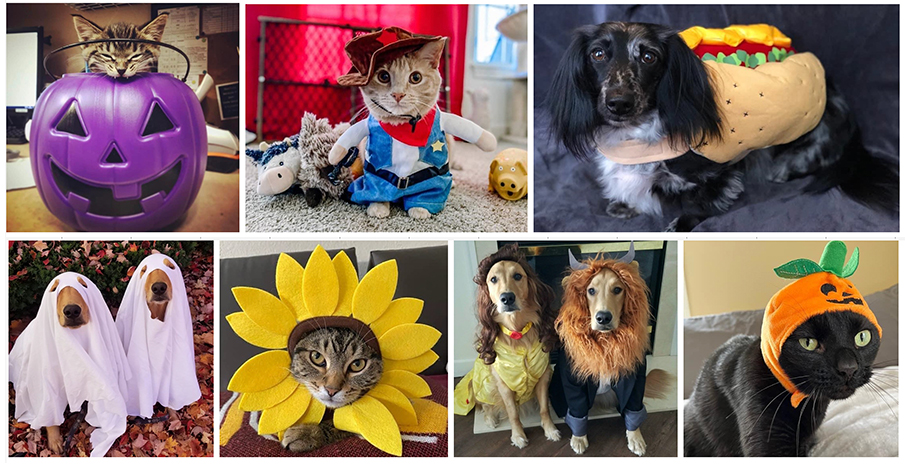
Arriba se muestran mascotas de los estudiantes de la University of Illinois College of Veterinary Medicine.
The end of summer can leave individuals with mixed feelings. Yes, it means the end of pool parties and summer BBQs, but it’s the start of sweater weather, pumpkin spice, and the holiday season. And with that comes family gatherings and, most important, sweet treats and great food!
Halloween and Chocolate
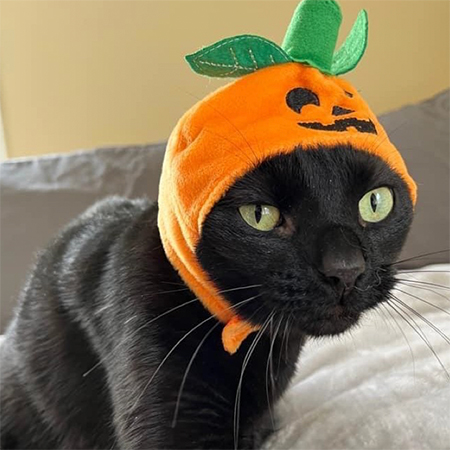
First on our list is the all-time favorite holiday of most kids (and many adults), Halloween. Not only do you get to dress yourself and your pets up as silly characters, but you can eat all of the candy in the world and not be judged.
That comes with a few responsibilities though. As many of you might or might not know, chocolate can be highly toxic to dogs and cats when ingested. How exactly can chocolate affect your pet, you may ask? Chocolate contains a toxin called theobromine, which animals can be very sensitive to because they cannot metabolize it as well as people can.
The amount of theobromine varies by the type of chocolate consumed. For example, baking chocolate contains more theobromine than milk chocolate, which contains more theobromine than white chocolate. In mild cases you may see signs of stomach upset like vomiting, diarrhea, and inappetence. More severe signs include seizures, panting, restlessness, nervousness, and twitching.
Regardless of the amount and type of chocolate consumed by your pet, it is important to reach out to either your local veterinarian or animal poison control. These resources can guide you to your next step to assure your pet stays safe and healthy.
Xylitol
An ingredient that can be harmful and even lethal to pets is called xylitol. Xylitol is a sugar substitute that can be found in many sugar-free candies, gum, mints, vitamin gummies, baked goods, etc.
Animal poison control (fees apply)
can be reached at:ASPCA National Animal
Poison Control Center:
888-426 4435
Pet Poison Helpline: 800-213-6680
Fun fact: toothpaste can also contain xylitol due to its flavor and antibacterial properties. This sugar substitute can be lethal in as little as an hour if a large amount is consumed by your dog. Xylitol consumption can lead to hypoglycemia, which can cause vomiting, weakness, incoordination, tremors, and ultimately seizures. It can also lead to liver failure due to excessive insulin release.
When in doubt and your pet gets a hold of and consumes something that you suspect contains xylitol in it, it is important to note the amount ingested and take your pet along with the original packaging to your local veterinarian for further treatment. You can also contact poison control for further recommendations.
Holiday Feasts
Turkey, ham, stuffing, mashed potatoes, mac and cheese, and my all-time favorite tamales. Now we’re getting into the food-filled holidays, which are my personal favorites. With some of our favorite dishes come some ingredients that aren’t the best for our furry friends. Onions, garlic, and chives give many dishes the extra taste they need.
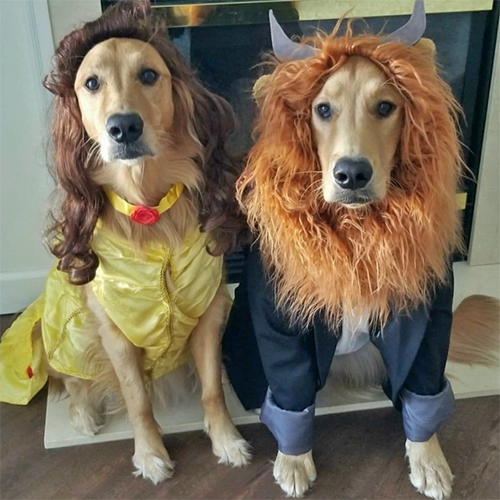
These savory additions can be harmful to our pets if ingested in a large quantity, even in dried, powdered, or cooked forms. The first signs that something is wrong are vomiting, diarrhea, gastroenteritis, and abdominal pain. More severe signs can take several days, but you can see increased heart and respiratory rate/effort, weakness, discolored urine, collapse, kidney damage, and even death.
These ill effects arise from oxidizing agents in onions and garlic, which cause oxidative hemolysis, meaning the destruction of red blood cells. We need red blood cells to carry oxygen throughout the body. If these blood cells are destroyed, vital organs cannot get enough oxygen. Early treatment can decrease the risk for serious effects, so if you suspect your pet has ingested something they shouldn’t have, contact your local veterinarian or poison control center.
It is also important to note that although ham off the bone is a delicacy during the holidays, feeding your domestic pet raw bones can be very dangerous. Bones can be a choking hazard and there is risk of injury if the bone splinters and becomes lodged or punctures your pet’s digestive tract. A foreign body surgery is a medical emergency!
High-Fat Foods
Now I won’t get into Christmas yet. I’ll save that for a later post. What I will mention is—yes, you guessed it!—pancreatitis.
What exactly is pancreatitis? Well, it’s inflammation of the pancreas. The pancreas is a small organ that is located just under the stomach and near the duodenum (a part of the small intestine). Its main job is to secrete digestive enzymes that help break down the nutrients in the foods we eat. It also secretes insulin and glucagon which help regulate the usage of those nutrients.
How do our pets get pancreatitis? A sudden meal high in fat is one of the classic presentations. Be sure to put all your holiday leftovers away in a place your pets cannot reach them, or they can get pancreatitis if they ingest a large amount of fatty foods. Other causes of pancreatitis include hormonal imbalances like diabetes mellitus and hypothyroidism, as well as certain drugs, pancreatic trauma, tumors, and obesity.
When there is inflammation of the pancreas, clinical signs that you may see in your pets include abdominal pain, loss of appetite, vomiting, diarrhea, and fever. If you suspect your pet might have gotten into food they shouldn’t have and notice any of the clinical signs mentioned above, reach out to your local veterinarian for further recommendations/treatment.
– Dr. Angelica Calderon
Toxicidades de Mascotas en Los Días Festivos
Llegar al final del verano puede tener personas con diferentes sentimientos. Sí, al terminal el verano significa el final de las fiestas en la piscina y las carnes asadas; sin embargo, es el comienzo del clima de suéter, pumpkin spice y los días festivos. Y con eso vienen las reuniones familiares y lo más importante, los dulces y la excelente comida!
Halloween y chocolate
Lo primero en nuestra lista es el día festivo favorito de la mayoría de los niños (y muchos adultos), Halloween. No solo puedes vestirte a ti y a tus mascotas como personajes chistosos, sino que también puedes comer todos los dulces del mundo y no ser juzgado.
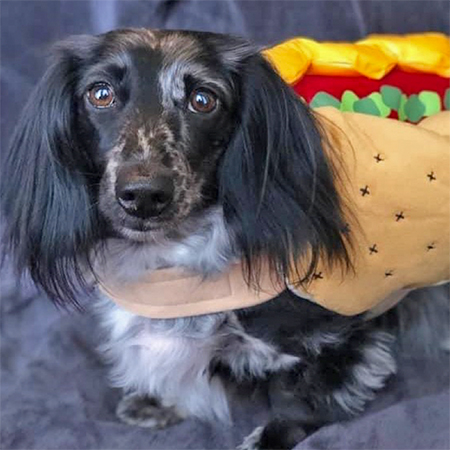
Sin embargo, eso conlleva algunas responsabilidades. Como muchos de ustedes saben, el chocolate puede ser altamente tóxico para perros y gatos cuando se ingiere. Cómo puede afectar exactamente a su mascota? Bueno, la toxina del chocolate que puede afectar a perros y gatos se llama teobromina, a la que los animales pueden ser muy sensibles porque no pueden metabolizarla tan bien como las personas pueden.
La cantidad de teobromina varía según el tipo de chocolate consumido. Por ejemplo, el chocolate para hornear contiene más teobromina que el chocolate con leche, que contiene más teobromina que el chocolate blanco. En casos leves, puede ver signos de malestar estomacal como vómitos, diarrea e inapetencia. Los signos más graves incluyen convulsiones, jadeo, inquietud, nerviosismo y espasmos.
Independientemente de la cantidad y el tipo de chocolate que consuma su mascota, es importante que se comunique con su veterinario local o con el centro de control de envenenamiento, donde podrán guiarlo mejor hacia el siguiente paso para garantizar que su mascota se mantenga segura y saludable.
El xilitol
Un ingrediente que puede ser dañino e incluso letal para las mascotas se llama xilitol. El xilitol es un sustituto del azúcar que se puede encontrar en muchos dulces que dicen “sugar free”, goma de mascar/chicles, mentas, vitamínicas en goma, galletas, etc.
Centro Nacional de Control de
Envenenamiento Animal de ASPCA:888-426 4435
Línea de ayuda para
envenenamiento de mascotas:800-213-6680
Dato curioso: la pasta de dientes también puede contener xilitol debido a su sabor y propiedades antibacterianas. Este sustituto del azúcar puede ser letal en tan solo una hora si su perro consume una gran cantidad. El consumo de xilitol puede provocar hipoglucemia que puede causar vómitos, debilidad, falta de coordinación, temblores, y convulsiones. También puede provocar insuficiencia hepática debido a la liberación excesiva de insulina.
En caso de duda y su mascota se apodera y consume algo que sospecha que contiene xilitol, es importante anotar lacantidad ingerida y llevar a su mascota junto con el empaque original a su veterinario local para recibir tratamiento. También puede comunicarse con el control de envenenamiento para obtener más recomendaciones.
Los días festivos llenos de comida
Pavo, jamón, relleno, puré de papas, macarrones con queso y mi favorito, tamales. Ahora estamos entrando en los días festivos llenos de comida. Con nuestros platillos favoritos vienen algunos ingredientes que no son los mejores para nuestras mascotas. Las cebollas, el ajo y las pasas son unos ingredientes principales en muchos platillos que les dan el último toque de sabor a nuestra comida.
Estos pueden ser dañinos para nuestras mascotas si se ingieren en gran cantidad, incluso en forma seca, en polvo o cocida. Los primeros signos que puede notar son vómito, diarrea, gastroenteritis y dolor abdominal. Los signos más graves pueden tardar varios días, pero puede observar un aumento de la frecuencia/esfuerzo cardíaco y respiratorio, debilidad, orina descolorida, colapso, daño renal e incluso la muerte.
Esto sucede porque contienen agentes oxidantes que provocan hemólisis oxidativa, lo que significa destrucción de los glóbulos rojos. Necesitamos glóbulos rojos para transportar oxígeno por todo el cuerpo y, si se destruyen, los órganos vitales no pueden obtener suficiente oxígeno. El tratamiento temprano puede disminuir el riesgo de efectos graves, por lo que si sospecha que su mascota ha ingerido algo que no debería, comuníquese con su veterinario local o con el control de envenenamiento.
También es importante tomar en cuenta que aunque el jamón es plato muy común en los días festivos, alimentar a tu mascota con huesos crudos puede ser muy peligroso. Esto puede ser un peligro de asfixia y existe el riesgo de lesiones si el hueso se astilla y se atasca o perfora el tracto digestivo de su mascota. Una cirugía para remover un hueso del estómago o intestinos es una emergencia médica!
Otras comidas que debe evitar alimentar a sus mascotas
Una comida con mucha grasa
Ahora no entraré en Navidad todavía, lo guardaré para otro blog. Lo que mencionaré es, sí lo adivinaste, pancreatitis.
Puede preguntarse qué es exactamente la pancreatitis, bueno, es la inflamación del páncreas. El páncreas es un órgano pequeño que se encuentra justo debajo del estómago y cerca del duodeno (una parte del intestino delgado). Su trabajo principal es secretar enzimas digestivas que ayudan a descomponer los nutrientes de los alimentos que comemos. También secreta insulina y glucagón que ayudan a regular el uso de esos nutrientes.
Cómo contraen pancreatitis nuestras mascotas? Pues, una comida repentina con mucha grasa es una de las presentaciones clásicas. Asegúrese de guardar todas las sobras de las fiestas en un lugar donde sus mascotas no puedan alcanzarlas, o pueden contraer pancreatitis si ingieren una gran cantidad de alimentos grasos. Otras causas de pancreatitis incluyen desequilibrios hormonales como diabetes mellitus e hipotiroidismo, ciertos medicamentos, trauma pancreático, tumores y obesidad.
Cuando hay inflamación del páncreas, los signos clínicos que puede ver en sus mascotas incluyen dolor abdominal, pérdida de apetito, vómitos, diarrea y fiebre. Si sospecha que su mascota pudo haber ingerido alimentos que no debería y nota cualquiera de los signos clínicos mencionados anteriormente, comuníquese con su veterinario local para obtener más recomendaciones/tratamiento.
– Dr. Angelica Calderon
The Weather Outside Is Fightful
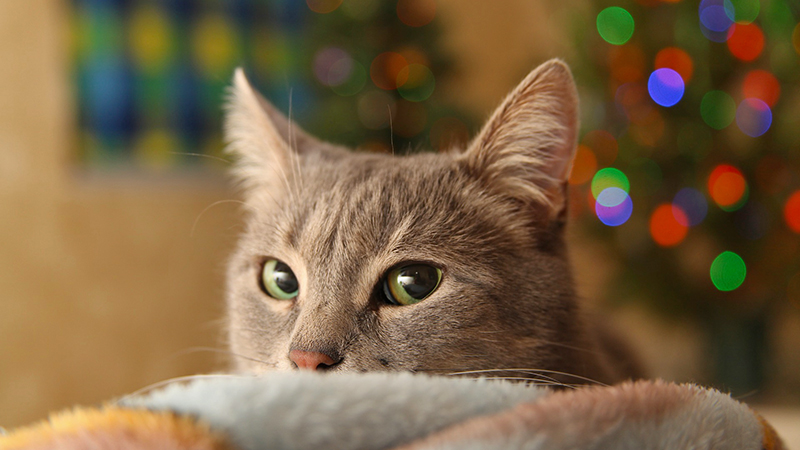
Oh, what a typical December in a year of continual peace and normalcy.
What’s your favorite holiday memory regarding socially distanced Zoom calls with family members you haven’t seen in person for years due to splintered political realities followed by a deadly pandemic all the while keeping your 6-year-old son inside and away from his friends for 9 months and simultaneously being forced to keep an external facade of sanity and light fun in your two-holiday household while your profession, which is universally adored and undervalued at the same time, is more in demand of your time than at any other period in history?
I have so many.
So we know what usually happens here on the holiday. There is a cute blog post about keeping your dogs and cats safe, titled something like “’Tis the Wheezin’: Asthma During the Holidays.” I have written some in the past (HERE), and feel free to read. It generally can be summed up by this wise adage: “Don’t let your dog and cat eat things or get burned and remember that New Year’s Eve in Chicago generally involves people who do not have children and animals lighting off fireworks late at night to make those of us who do angry.” And don’t buy puppies, kittens, or bunnies as gifts. Instead, buy books like this inspirational tale for the animal lover in your life.
But I’m going to write about an unrelated topic: domesticated cats and the outdoors. I can imagine, even before writing this, that many people have strong feelings about this topic. My intention is not to pass judgment on anyone. I want to just give you the veterinarian perspective, and possibly give you an excuse to see photos of my fat indoor cats sitting next to holiday decorations, because that is how we indoor-cat people are generally seen and heard.
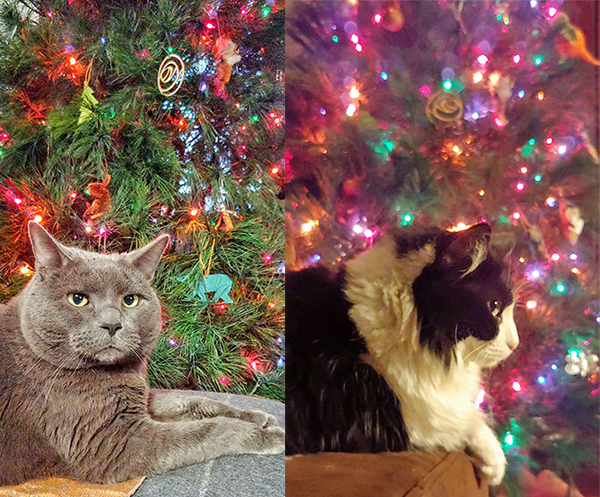
Some cats go outside. Cats go outside because some people feel that they have no choice but to let the cat out. Some people feel that it is philosophically cruel to not let the cat out, and some cats get outside by accident. All are acceptable.
I will be upfront and tell you that my two cats, Crocodile the Russian Blue mutt and Penelope the one-eyed tuxedo, do not go outside. They both try at times and have both gotten out before, but they stay inside and tolerate the complete subservience of all surrounding them.
Some of the dangers facing an outdoor cat are pretty obvious, but let’s go through them (you and I, together, like old friends who aren’t being watched):
1. Fighting with Other Cats
Cat bites and scratches are bad, cause severe infections, and can be fatal. All veterinarians have seen cats brought in with bite wounds that have become severely infected and, at worst, can puncture the abdomen, chest, eyeball, or throat and need surgical fix, hospital stays, and even euthanasia. We clean it up and give antibiotics, but it’s always concerning. This also can lead to:
2. Spread of Infectious Disease
Feline leukemia virus (FeLV) and feline immunodeficiency virus (FIV) are spread through the exchange of bodily fluids (blood, saliva, etc.). Let’s just assume that the cats outside getting into fights are mostly ones that are homeless, and that homeless cats comprise the largest population of cats carrying these viral diseases. Well, the logic chain/train follows, and you see the danger. We can vaccinate for FeLV, so if your cat does go outside, you can get this done. There is no vaccine for FIV. And no treatment for either disease.
3. Other Infectious Disease
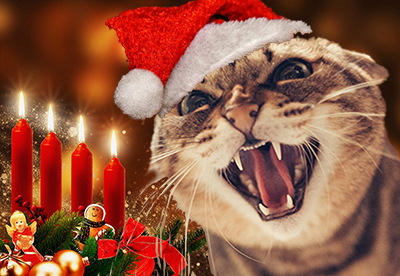
Rabies is a classic viral hit and can be spread through other cats or wild animals (bats, skunks, foxes). Make sure your outside cat is vaccinated for rabies, not only because it is the law but also because, even though it is rare, your sweet rabid cat can kill you and your family. (Still waiting for the Hallmark Channel’s Very Special Rabies Christmas.)
Just for fun let’s add endless respiratory infections (that can pass on to the other cats in your house), feline distemper (get your cat vaccinated for that, too), and parasitic diseases such as fleas (get monthly flea protection), ticks (get monthly tick protection), ear mites, intestinal worms (have monthly dewormers given), and ringworm.
All but one of these diseases can be passed on to you, your children, your grandparents, their friends, their friends’ neighbor, your friends’ neighbors’ son’s cat, etc. You see how this works. If you have an outdoor cat, and you’re afraid to tell your veterinarian (which you shouldn’t be), you can still take all the precautions: vaccines, preventatives, etc.
4. And Even More Infectious Disease
For the lucky, cats bring home presents, such as mice, birds, rats, etc. The rodents bring diseases and other rodents. It’s endless.
5. Cats Get Hit by Cars…
… get hit by bikers, get stuck in garages, get hurt by bad people, get snagged on fences, freeze to death, etc. [Cut to unwatchable montage of more horrible things.] It happens.
My previous cat got stuck in someone’s garage. I could not find her and searched for hours around the neighborhood. I eventually heard a cat crying in a garage and called the police who, hours later, located the owner who wasn’t on premise, to open the door. That could have easily gone another way, and I will write that fan fiction novel later.
“Lost cat” signs litter my current neighborhood, and you know they aren’t lost with a hobo bag on a train. They are all either dead, or (at best) living their lives with someone else. Also please have your outdoor cats microchipped. It’s not painful and may save your cats’ lives. You can also buy GPS trackers for their collars. I am not promoting a specific brand, but they are available anywhere.
6. Overpopulation
Cats are really good at making babies, causing the population of stray cats in the city to blow up. These cats either end up being helped by people/shelters that can barely deal with the cats they have or they are left to fend for themselves on the streets to die, starve, or spread more disease.
So first, get your outdoor cat spayed or neutered. It is absolutely the best thing for them, for their health, and to keep down the population of wild cats in need. I also do not need to explain to you how a wild tom cat will treat a sweet young lady cat taking a stroll down the promenade with her uterus and ovaries. If you want to reduce the chances that your boy cat doesn’t get into a fight, well, then neuter. There are conflicting statistics, but most sources suggest that one female cat and her mate and all the subsequent offspring amounts to 11 million cats in nine years.
7. Anti-Nature
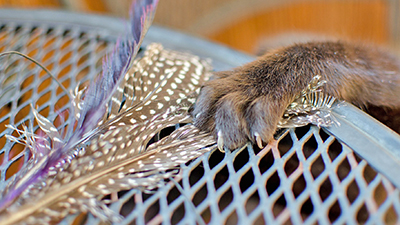
Lastly, I fear that some of you feel like the most natural thing for the world is to let your cats outside and let them live the full entirety of their existence. I get this, I really do, but also understand how much destruction to the natural environment cats do. They destroy natural foliage and other wildlife despite their good intentions. There is some very good evidence that the best thing for “nature” is to keep your cats inside, and you can find many other resources on this topic.
There are cats that do better when they go outside. I’ve had clients keep their cats inside and later see them become anxious, yowl, not eat, urinate all over the house, etc. I don’t want your cats to suffer, but if you want to make that transition, there are things we can do. It may not be the case that your cat is anxious because it can’t go outside. In fact, it may be that it has always been anxious, but you never noticed until you kept it inside. Always have us examine your cat before making any judgments. Maybe your formerly outdoor cat is suffering from something else (UTI, pain, etc.).
As always, feel free to discuss with us at any time. This wasn’t meant to be a philosophical treatise on domesticated animals’ rights, though that is generally how I fantasize spending a great deal of my off time.
Try to relax during these times and make sure you don’t feed your dogs chocolate-covered antifreeze-infused garlic balls for the holidays, or give your cats kerosene holiday lamps for Hanukkah.
I will continue to lord over Secret Santas everywhere while I fulfill my long-standing December tradition of making holiday cookies I can’t eat in a house I don’t own.
Be safe, don’t travel, wear masks, and shop locally on-line. And Black Panther is a holiday movie.
— Brett Grossman, DVM
